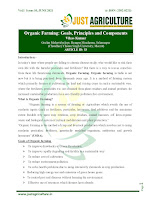Fungi Definition:- "Fungi are eukaryotic spore bearing achlorophyllous organisms which may reproduce sexually and asexually and whose filamentous branched somatic structures are typically surrounded by cell walls containing chitin cellulose or both of these substances."
Fungi reproduce both asexually (without a nuclear change) and sexually (with a nuclear change). The reproductive bodies are called as spores which are capable of growing into a new thallus.
The
reproductive phases starts when the vegetative phase (Somatic phase) has
reached certain degree of maturity so as to provide sufficient quantities of
reserve food for the spore producing organs.
The reproduction in fungi takes place by the following methods:-
Asexual reproduction:- It
is otherwise called as vegetative or somatic reproduction and it does not
involve the union of sex organs (gametangia), sex cells (gametes) or nuclei.
The spores produced by asexual reproduction are called as mitospores since they
are formed by meare mitotic division of nuclei and the daughter cells have the
genetic constituent as that of original cells.
In
fungi, the asexual reproduction takes place by the following methods:-
1. Fission:- Some types of yeast
undergoes this type of reproduction. Nuclear of a somatic cell divides
miotically and the cell contents become divided into two halves by the
formation of transverse septum. Later the two separated cells get round off and
become individual thalli.
2. Budding:- It is also a common method
of reproduction in Saccharomyces spp. The unicellular thalli put forth one or
two buds which enlarge gradually. The protoplasmic contents including
mitotically divided nuclei pass into the bud, and then the buds cut off to
become a new thalli.
3. Fragmentation:- Hyphae break up into
their component cells which behave like spores. These spores are called as
arthrospores or oidia (eg). Oidium species.
4.
Production of asexual spores:- Fungi produce
different types of asexual spores viz., (Zoospore, aplanospore sporangiospores
and conidia).
(A). Zoospore (Motile spore/Planospore/Swarm spore):- It is a motile asexual spore produced mostly by the lower fungi belonging to mastigomycotina subdivision. They have one or two flagella for motility in the surrounding film of water and are spherical or reniform or pear shaped. Zoospores have hyaloplasm membrane cover and are uninucleate and haploid.
Two
types of flagella are found:-
1.
Whiplash (Acronematic or Peitchgeisal flagella)
2. Tinsel (Pantonematic or flimmer or flimmer geisel flagella)
After released from the sporangia or from the vesicle, the zoospore pass through three distinct phases viz., motility, encystment and germination. Zoospores aid in initiating new generation and spread of the fungus. But in some lower fungi, they also act as gametes.
(B). Apalanospore:- These are non motile asexual spores produced by many type members of zygomycotina fungi inside the sporangia. They are either uninucleate or multinucleate, formed only at the periphery of the sporangium with an empty centre and base which is called as columella (eg) Mucor sp, Rhizopus sp.
(C).
Conidia:- Conidia are the asexual spores produced by most of
the higher fungi (terrestial fungi) including ascomycotina, basidiomycotina and
deuteromycotina. Generally the term conidia is used for any asexual spore other
than sporangia and spores formed directly by the hyphal cells. Conidia are
formed singly or in chains on a special spore bearing hyphae called as
conidiophore.
Conidia
borne as buds or blown out tips in acropetal chains are also called as
blastospore (eg) Cladosporium spp. Conidia are of various shape, size,
uninucleate to multinucleate, unicellular to multicellular, without pigments or
with pigments ranging from light olive to deep black. The conidiophore may be
free, simple branched and distinct from each other of may be aggregated to form
compound sporophore called as fruiting bodies.
The asexual fruiting bodies produced by the fungi are:-
(a). Synnema (Pl . Synnemata):- It is the loose aggregation of erect conidiophore so as to form a dense fasicle, similar to mycelial strand. The conidia are produced at its apex (eg) Ceratocystis sp, Graphium sp.
(b). Sporodochium
(Pl. Sporodochia):- It is a fruiting body peculiar to the
fungi Fusarium sp. It is a cushion shaped aggregation of hyphae which breaks
through the host surface and bears conidiophore.
(c). Acervulus
(Pl. Acervuli):- Most of the fungi belonging to the
order melonconiales of the deuteromycotina sub division produces acervuli. It
is a saucer shaped depressed mass of aggregated hyphae bearing conidiophore in
a compact layer on its exposed surface (eg) Colletotrichum sp, Pestalotia sp.
(d). Pycnidium
(Pl. Pycnidia):- It is a hollow, flask shaped or globose
fruiting body with a narrow mouth (Ostiole) whose pseudo parenchymatous inner
walls (Peridium) are lined with conidiophore which bear conidia (eg)
Macrophomia phaseolina.
(e). Sorus
(Pl. Sori):- Sorus in Greek means heap. ie., the
spore bearing hyphae are grouped into small to large masses or clusters (eg)
smut sori, rust sori.
Thank You
Vikas Kashyap:)










1 Comments
Very nice content
ReplyDelete